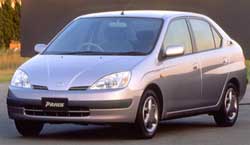

Cars that can be used normally and that minimize the burden on the environment

In December 1997, Toyota began marketing a hybrid car as a general passenger car. The merit of this car is that it handles the same as existing cars-it does not involve any changes to a car's fundamental performance-while reducing harmful effects on the Earth's environment. Through the combination of a high-efficiency gasoline engine with an electric motor, the car's fuel efficiency is roughly 100% greater than, existing gasoline-powered cars and emissions are reduced to approximately one-tenth. Top priority was given to the environment and fuel consumption in the design of this gasoline engine, and success is achieved in reducing emissions by rotating the motor at the ideal speed at all times. The gasoline engine and electric motor are used selectively to achieve maximum efficiency. A computer in the car automatically switches back and forth, using the electric motor alone at low speeds, where engine efficiency is poor, and the gasoline engine and motor together during normal driving.  A generator is built into the power generating components that can charge the electric motor while the car is running. The kinetic energy that escapes as heat during braking in conventional cars can be converted into electric power and stored in the car's battery. The only fuel the user needs to directly purchase is gasoline, which means that the hybrid car can be used just like an ordinary one. The greatest problem at this point in time is cost. It is hoped that costs can be brought down in the future through mass production and technological innovation through competition between carmakers. Photo: (From Top) Toyota Prius , Engine and Transmission of Prius (Toyota Motor Corporation) Unauthorized reproduction of thephotos in this page is prohibited. |
|